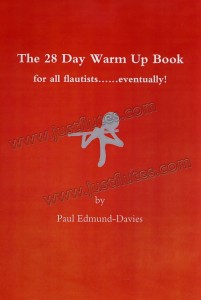 Recently I have enjoyed working from Paul Edmund-Davies “The 28 Day Warm Up Book, for all flutists…..eventually!”. Its (English-only) text is extremely clear, with touches of humor that engage the reader from the start. His approach is extremely practical and humane. There is advice on how to approach your practice, how to structure it, and the empty staff paper at the end of each section encourages further thought and creativity for your own exercises.
Recently I have enjoyed working from Paul Edmund-Davies “The 28 Day Warm Up Book, for all flutists…..eventually!”. Its (English-only) text is extremely clear, with touches of humor that engage the reader from the start. His approach is extremely practical and humane. There is advice on how to approach your practice, how to structure it, and the empty staff paper at the end of each section encourages further thought and creativity for your own exercises.
The daily exercises cover four areas: sonority, fingers, articulation and intervals. I felt compelled to write about my experience with these exercises because it is a lesson in humility. With several decades of professional playing under my belt, I took a look at some of the pages and thought “how simplistic, I don’t need that stuff”. But playing them, I realized that they were quite challenging. So I got to work. And they sound nice! My family particularly likes to hear me practice Articulaton no. 7.
A number of exercises I find useful for piccolo practice. Intervals no. 2 is not only good for intervals, but makes a great intonation study if played with a drone from a tuner or computer. (How I wish I had a live tambura player to assist me :-)). Articulation no 6, with its combination of repeated and moving notes, is especially good for controlling the sometimes tricky middle register of the piccolo.
The section on fingers I find very practical. He points out that scales are all well and good, but they don’t really train the fingers to lift and close with swift independence. The exercises, some of which are based on Taffanel & Gaubert, reinforce this idea. Because its familiarity makes for easy memorization, I am a great adapter of T&G myself, and am always happy to learn other approaches.
Here on YouTube, you can watch Paul Edmund-Davies demonstrate some of his exercises in the context of learning Anderson’s Op. 15.
For those who are interested, my complete warm-up these days goes as follows:
- harmonic studies, with and without articulation, add trills
- finger and articulation exercises, including scales and written exercises from this book. As I have written elsewhere, I find Peter Lloyd’s approach works well with me: Get really warmed up first, and then do sonority work.
- combined melodic sonority/intonation/interval exercises from this book and others
You see, I have gotten away a bit from long tones. They can be useful, and I may come back to them at another point. But for now, I find melodic studies and other exercises from “de la Sonorite” more useful. Gotta do what works!






